Why has my potted hydrangea died? Common Causes and Solutions
If you’ve noticed your beloved potted hydrangea looking wilted or losing its vibrant colors, you’re not alone. These beautiful plants can be quite picky when it comes to their environment.
A common reason for a potted hydrangea dying is improper watering. You should find the right balance to avoid stressing the plant.
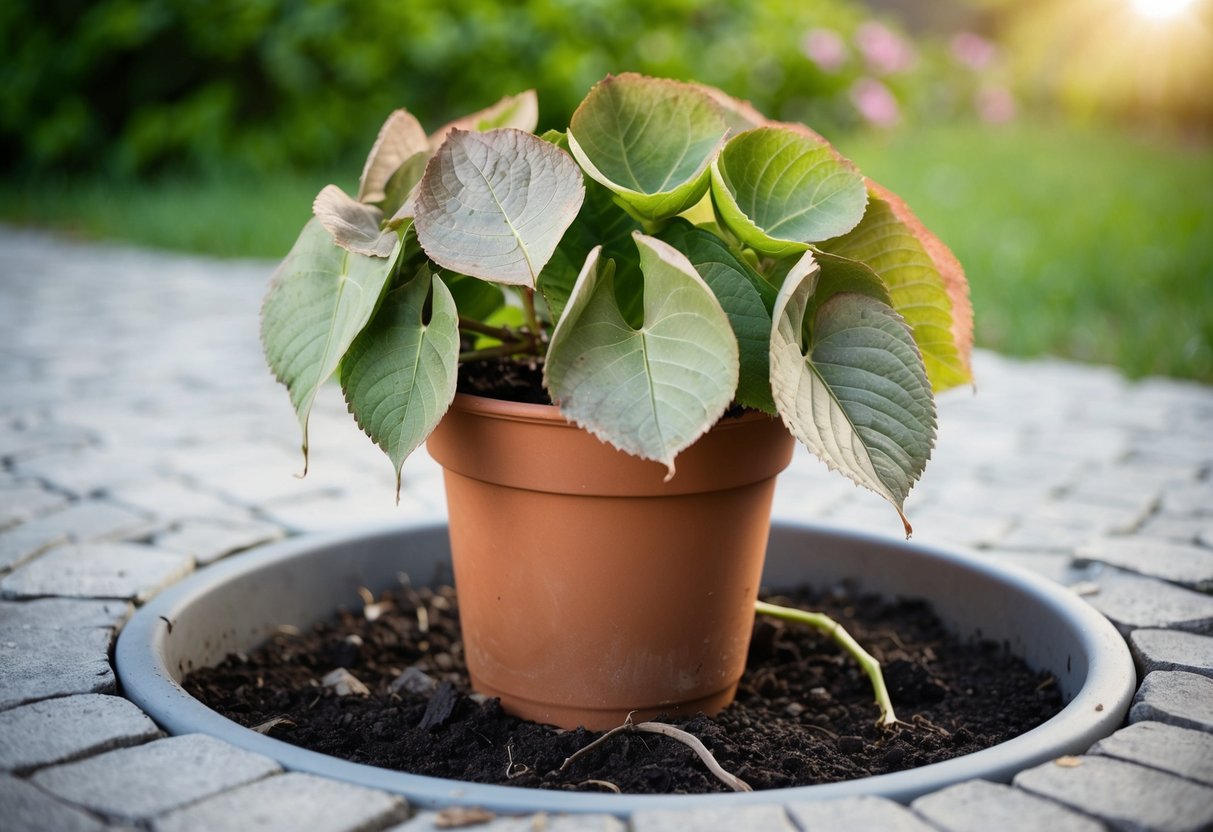
Besides watering, other factors could be affecting your hydrangea’s health. Too much direct sunlight can scorch the leaves, so make sure your plant is in a spot with partial shade.
Checking the soil is also important, as hydrangeas prefer slightly acidic soils.
Also, consider whether your plant might be suffering from a nutrient imbalance. Sometimes, using too much fertilizer can harm rather than help, causing leaves to brown. Once you identify the issue, you can often bring your plant back to life.
Identifying Common Signs of Distress in Hydrangeas
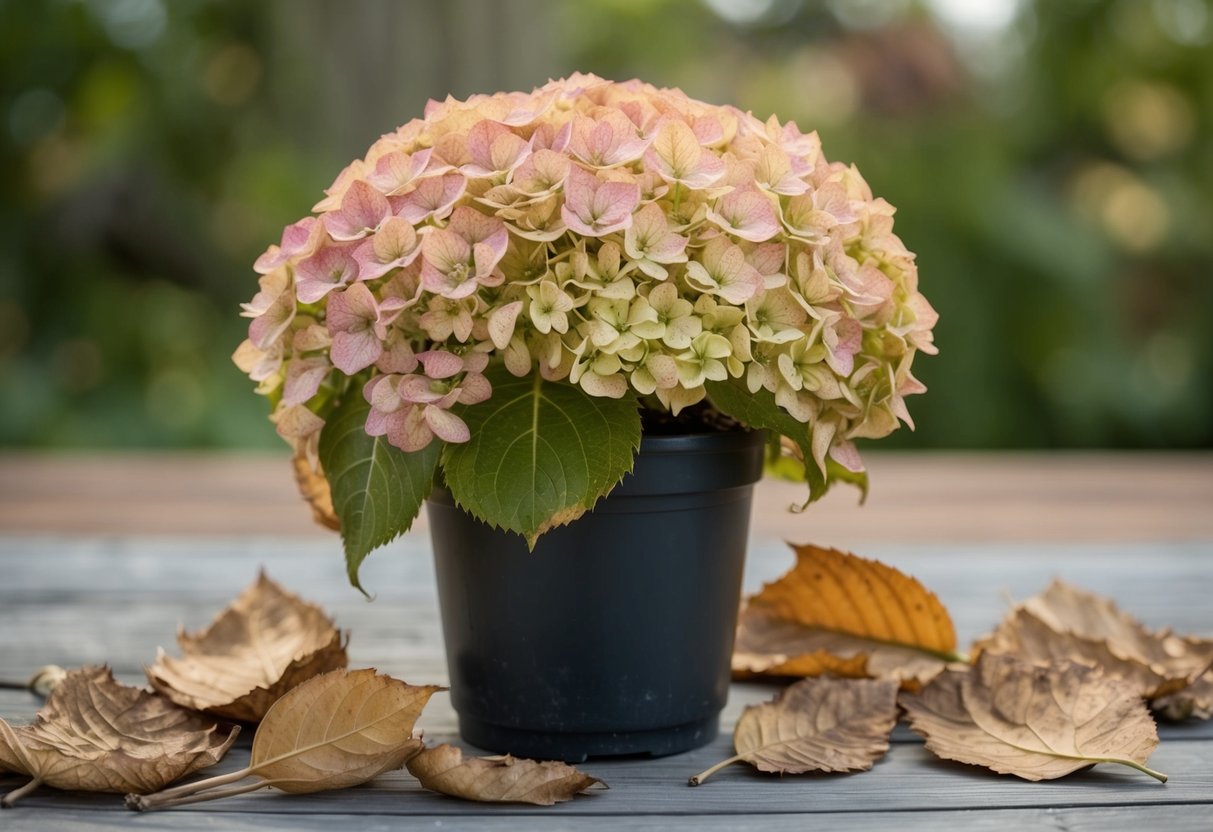
When your hydrangea starts showing signs of distress, it’s important to act quickly. Recognizing issues like wilting leaves, yellowing, and browning flower buds can help you revive your plant. Understanding these signs can make it easier to get your plant back to its healthy state.
Wilting Leaves and Yellowing
If you notice the leaves on your hydrangea wilting, it could be a sign of either too much or too little water. Hydrangeas like evenly moist soil, so check the soil’s moisture level.
Dry soil means you should water more frequently, while soggy soil may indicate poor drainage. Both can stress the plant, leading to wilting.
Yellowing leaves could signal nutrient deficiencies, particularly in nitrogen or iron. Test your soil’s nutrient levels to determine if you need to fertilize.
Too much sun is another factor. Hydrangeas usually prefer morning sun and afternoon shade. If they’re in direct sunlight all day, consider moving them to a shadier spot.
Browning Flower Buds and Poor Blooming
Browning flower buds often suggest dehydration or excessive sun exposure. Ensure your hydrangea has access to consistent moisture, especially during dry spells.
Placing mulch around the plant can help retain soil moisture and protect the roots from extreme temperatures.
Poor blooming could be due to over-fertilizing, which leads to excessive leaf growth at the expense of flowers. If you’ve recently added fertilizer, scale back to see if the blooms improve. Late spring frosts can also damage flower buds. To protect them, consider covering your plants if cold weather is forecasted.
Understanding Hydrangea Water Needs
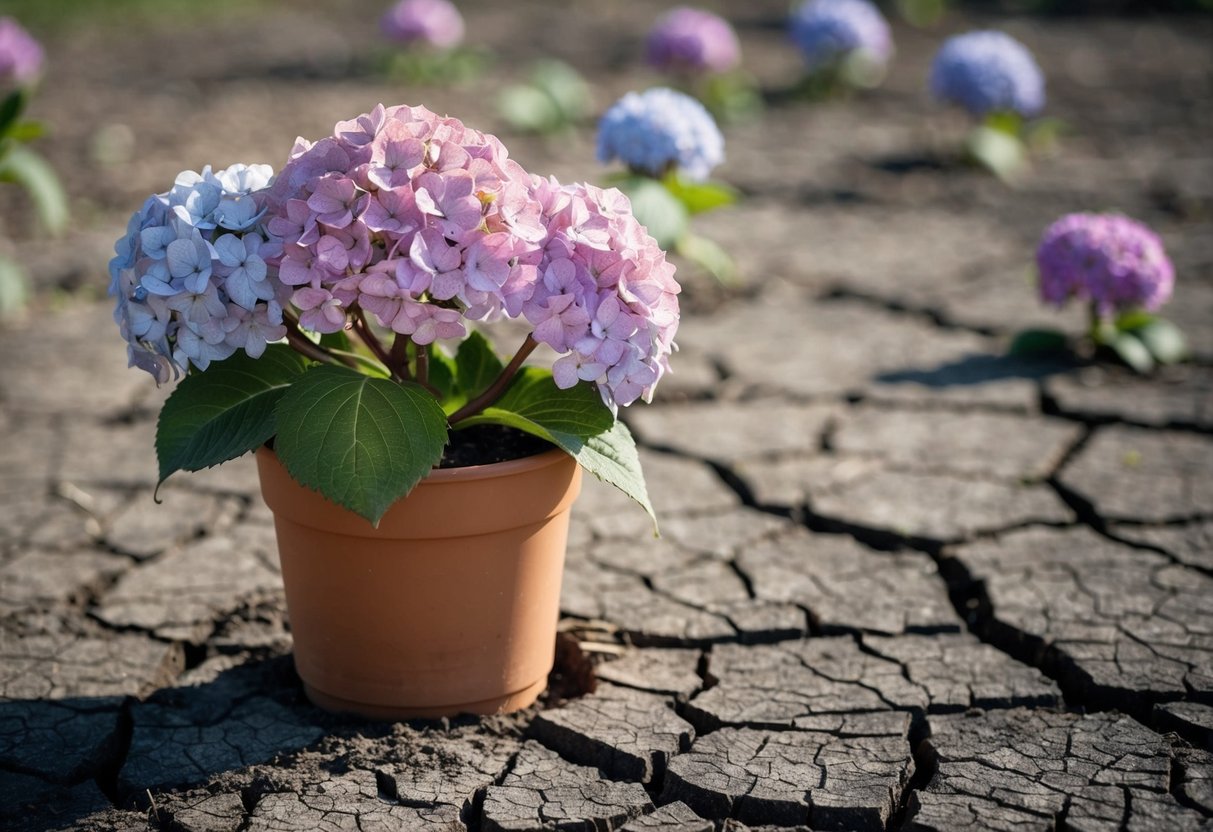
Hydrangeas have specific water needs to keep them healthy. Both too much and too little water can harm your plant. Recognizing the symptoms of overwatering and underwatering is key to caring for your hydrangea.
Symptoms of Overwatering
Your hydrangea may be overwatered if its leaves turn yellow or start wilting, even while the soil remains damp. Overwatering can lead to root rot, a condition where roots sit in water too long and decay.
If you notice a mushy stem, it’s a clear sign of too much water. Roots need air just as much as they need water. When soil becomes soggy, it blocks air pockets, suffocating the roots.
Another sign is mold on the soil surface. If you spot any of these symptoms, try reducing the amount of water you give your plant. Ensure the pot has drainage holes that prevent water from pooling at the bottom.
Signs of Underwatering
An underwatered hydrangea will have dry, crispy leaves. The leaves may curl up at the edges and turn brown. If you check the soil and it’s dry to the touch an inch below the surface, it’s likely a sign of too little water.
Flowers might also droop and become lifeless. Observing the plant during the morning is the best time since heat later in the day can cause temporary wilting. Consistent underwatering can cause stress and stunt the growth of your hydrangea.
To help fix this, increase your watering frequency. Ensure your plant receives enough water to moisten the soil without being excessive. Daily checking is useful to understand your plant’s needs better.
Proper Watering Practices
Water deeply to make sure the moisture reaches the roots. This encourages root growth and strengthens the plant.
It’s best to water your hydrangea in the morning. Early watering allows any splashes on the leaves to dry during the day, reducing the risk of fungal diseases.
Aim to keep the soil consistently moist but not soggy. Water less often but with more quantity. Mulching around the base can help retain moisture and regulate the soil temperature, benefiting your plant greatly.
Using a moisture meter can provide guidance on when to water. Adjust your practices if you see signs of overwatering or underwatering to meet your hydrangea’s needs.
The Role of Sunlight and Shade in Hydrangea Health

Hydrangeas need a balanced amount of sunlight and shade for optimal growth. Too much sun can harm them, while proper shade protects them from harsh conditions.
Managing Sun Exposure
Hydrangeas enjoy sunlight, but not too much! Morning sun is best because it’s gentler. It gives the plants the energy they need without scorching the leaves.
If your hydrangea gets too much sun, you might notice it wilting or the leaves turning brown.
Try finding a spot where your plant can get about four hours of morning sun daily. In the afternoon, dappled light works great. It provides enough light while protecting the hydrangea from harsh rays. Adjusting their position can make a big difference in how healthy they look.
Shade Requirements and Protection
Afternoon shade is important for hydrangeas. In warmer climates, the afternoon sun is too intense and can dry out your plant.
Choose a place with some natural shade, like near a tree or a building that casts a shadow.
If there isn’t enough natural shade, consider using a shade cloth. This helps protect your hydrangea from excess sunlight exposure. You can also use larger plants to create a shaded area. Keeping your hydrangeas in a spot with the right balance of light and shade can significantly improve their health.
Soil and Fertilization Factors
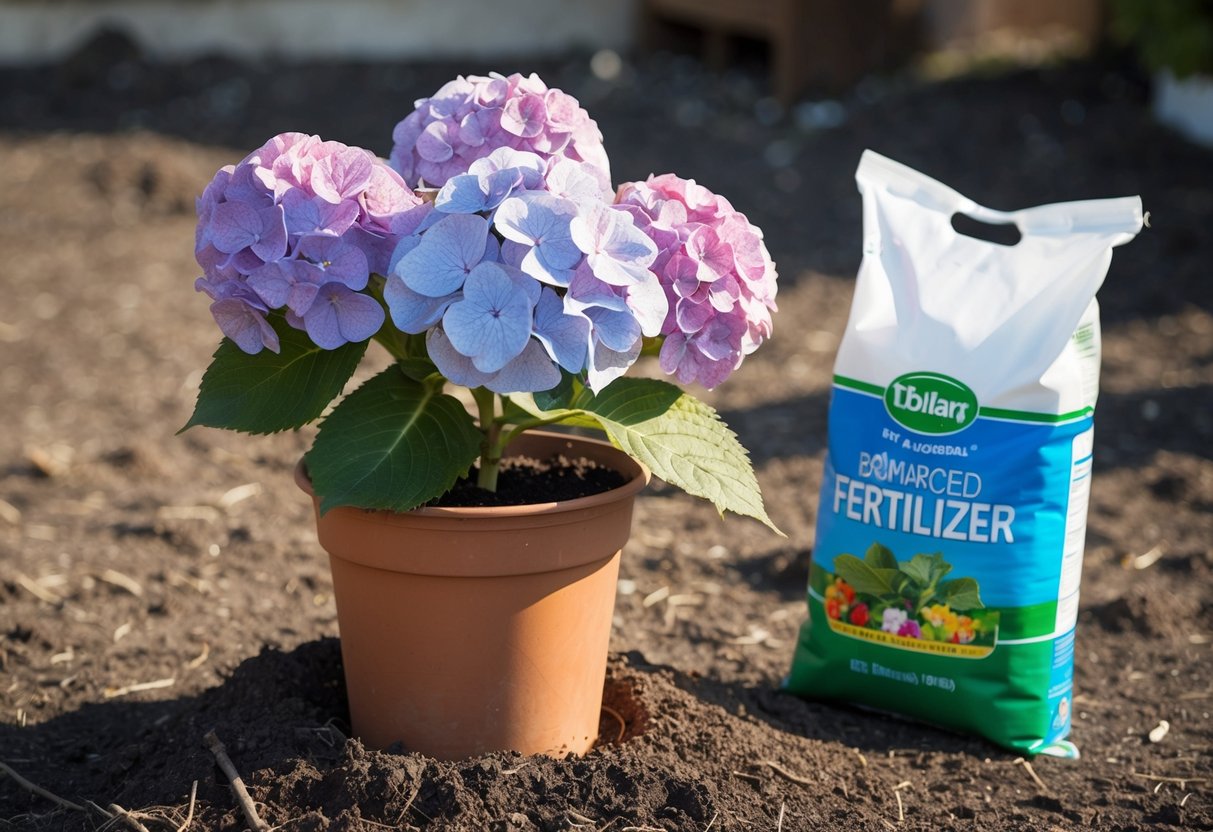
Proper care of your potted hydrangea involves attention to both soil conditions and fertilization. By understanding these factors, you can prevent issues like poor growth or leaf damage.
Soil Conditions and Drainage
Good soil is vital for hydrangea health. Your plant needs well-draining soil to prevent water from sitting at the roots, which can cause root rot.
Incorporating organic matter like compost can improve both drainage and soil structure. Compost not only helps with drainage but also retains the right amount of soil moisture.
When choosing soil, look for a mix that includes elements like sand or perlite. These materials promote better air circulation and drainage.
Placing a layer of mulch around the base can help maintain the soil’s moisture levels and temperature balance. Avoid heavy clay soil, as it tends to hold too much water.
Fertilizer Use and Over-Fertilization
Fertilization must be done carefully. Hydrangeas can be sensitive to too much fertilizer, especially high nitrogen content. This can burn the roots and cause leaf edges to turn brown.
It’s essential to follow the recommended amounts on the fertilizer package to avoid damage.
Opt for a balanced fertilizer or one specially formulated for flowering plants. Applying compost not only enriches the soil but can also provide necessary nutrients.
Watch out for runoff from lawn fertilizers, as they can affect your hydrangea too. Using a slow-release fertilizer can ensure nutrients are gradually absorbed, promoting steady growth.
Protecting Hydrangeas from Environmental Stresses
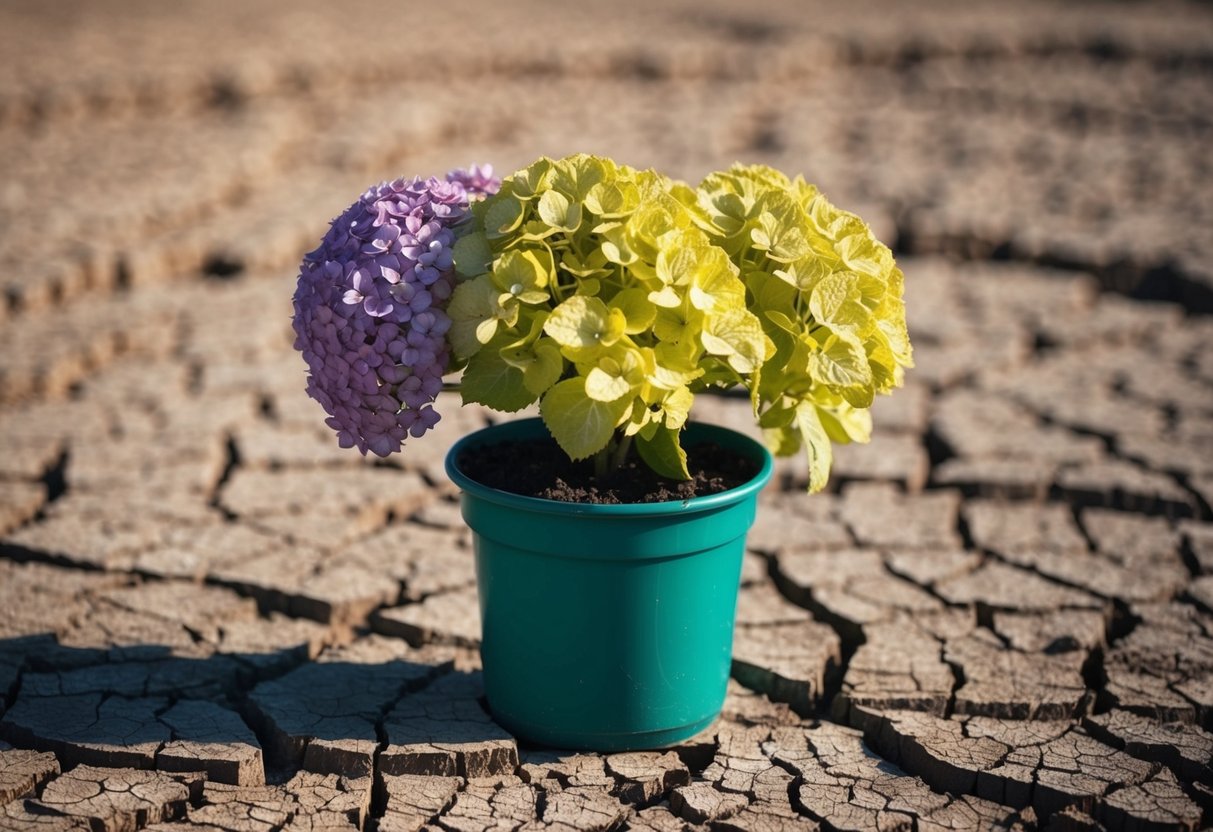
Caring for hydrangeas requires attention to various environmental factors. Key issues involve managing temperature extremes and preventing pests and diseases that can harm the plant.
Dealing with Extreme Temperatures
Hydrangeas can suffer from drought stress during high temperatures. To help, water them deeply but less frequently to encourage strong root growth.
Mulching can keep moisture in the soil and protect roots. On hot days, providing afternoon shade can prevent wilting and sunburn.
In cold climates, late frosts and cold winds threaten your hydrangeas. Covering them with breathable fabric or moving potted plants to a sheltered spot can prevent frost damage. Watching weather forecasts helps you know when to take action.
Preventing Damage from Pests and Diseases
Hydrangeas face threats from pest infestations and diseases like mildew. Regularly check leaves for pests. If you spot problems, use insecticidal soap to get rid of them. Make sure to choose something suitable for hydrangeas.
To prevent mildew, ensure proper air circulation around the plant and avoid wetting foliage when watering. Placing hydrangeas in well-draining soil can also protect them from root rot, which occurs when roots stay too wet. By keeping humidity levels balanced, you’ll create a healthier environment for your plants.







